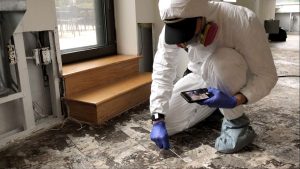The Importance of Snow Removal from Commercial Roofs
6 min read
xr:d:DAGCAsx4Nnw:4,j:257129606071269196,t:24041011
While snow-covered roofs may look scenic on holiday cards, heavy snow accumulation poses significant risks. Even a few inches of snow can overload aging or vulnerable roof structures.
Building owners must hire professional snow removal agencies to ensure snow removal is maintained throughout winter.
The following details snow removal, its importance, risks, and the practises that professional commercial and residential roofing companies employ to remove snow properly.
Why Is It Important to Remove Snow from Commercial Roofs?
Allowing a flat commercial roof to accumulate snow creates various possible risks. Some of the most common and significant risks are as follows:
1. Limited or Blocked Access to Building Systems
Snow buildup blocks entry points and covers systems like HVAC and vents, preventing maintenance crews from accessing various building parts for maintenance and service.
Proper building operation may be affected, leading to potential losses and even lawsuits.
2. Falling Snow and Ice Hazards
Unchecked ice or snow piled up on edges may fall onto people and property below, causing injuries to individuals and property damage.
When heavy loads of ice fall from the roof surface, it can also damage the roofing membranes on lower roof areas, leading to further property damage.
3. Drainage Damage from Meltwater
Clearing snow accumulation from rooftops helps to prevent harm to drainage systems. When snow eventually melts on the roof, the meltwater can infiltrate the drainage infrastructure.
While internal piping often stays warm enough not to freeze, external drainage lacks insulation against cold.
Further, freezing water expands inside these external pipes, causing them to break.
4. Freeze-thaw Degradation of Membranes
Repeated freezing and thawing can degrade roof membranes over time. During daytime warmth, accumulated snow melts into water and freezes as temperatures drop at night.
With this freeze-thaw process occurring daily, membrane damage may escalate.
5. Load Dangers from Heavy Accumulation
Excess snow accumulation risks overloading rooftops beyond their weight limits, endangering a potential collapse in severe cases. Though rare, roof failure from heavy snow loads poses severe consequences.
Effective snow management should incorporate precautions against this possibility.
What Are the Warning Signs of Building Stress After Snowfall?
FEMA provides a list of signs that indicate snow loads may overly strain a building, including the following:
● Ceiling Issues: Sagging ceilings or lowered sprinklers and heads could indicate snow issues.
● Strange Noises: Creaking, popping, and cracking sounds may indicate roof stress.
● Roof Problems: Any sagging roof membranes or trusses may indicate excess weight on the roof.
● Drainage Issues: Flattened areas on flat roofs that pool meltwater indicate snow accumulation.
● Door and Window Faults: If doors or windows cannot be opened or closed, this can indicate shifted framing, possibly due to excess weight from snow.
● Wall Defects: Any cracking in the drywall or masonry may be due to an overloaded roof.
Contact a professional commercial snow roof removal agency immediately if any indications present themselves.
How to Prevent Snow Risks on Commercial Flat Roofs?
Take necessary precautions to prevent snow from accumulating on a building’s roof.
Here are a few practical measures to reduce snow-imposed hazards and snow accumulation on rooftops:
1. Professional Roof Inspection
Schedule comprehensive examinations before winter, focusing on snow and ice-prone areas to quickly address any identified vulnerabilities before winter comes.
2. Installation of Wind Baffles
Take adequate steps to prevent snow from entering drains, vents, and other access points. Many professional agencies can help to mount wind baffles easily.
3. Install Snow Guards
Snow guards are commonly found on metal roofs. However, they also benefit flat roofs and safeguard plumbing vents and airways from drift coverage.
4. Map the Rooftop
Mapping the roof is another effective way to improve the efficiency of snow removal. Detail the roof layout, highlighting features, drainage, and drift-susceptible zones. Hire a roofing company to help with mapping.
Reasons to Hire Professional Snow Removers
Snow removal is a risky job. The proper equipment, experience, and expertise are required to remove snow.
Hiring a snow removal agency in your local area is crucial for the following reasons:
1. Proper Equipment
Having the right equipment and gear to remove snow is a prerequisite to getting the job done right.
A professional team uses industrial-grade snow blowers, plows, roof rakes and other specialized tools that clear snow thoroughly and efficiently, ensuring the snow gets removed without causing any trouble.
2. Training and Technique
Snow removal is a dangerous job. Roofs are high and wet with ice.
Hence, only a team with proper training and technique knows how to clear the snow, including strategic approaches to avoid structural damage or safety hazards.
3. Time-Saving
Removing snow from a roof is a time-consuming job. Hence, it makes more sense to have a professional team do it, as they are more efficient at the job and can complete the task far faster than any DIY effort.
4. Avoidance of Physical Strain
Clearing snow is intensely laborious and potentially dangerous. Hiring a professional team is the best course of action as they are experts.
5. Code Compliance
Commercial properties often face municipal snow removal regulations that professionals are better equipped to fulfill.
Hired professionals will also take care of the necessary paperwork.
6. Reliability
Snow removal companies operate on schedules, ensuring properties are cleared of snow when needed. This reliability is essential for businesses, ensuring operations can resume promptly.
As professionals, they are contractually required to deliver the work.
7. Cost-Efficiency
While there is a cost associated with hiring professionals, it can be cost-effective in the long run.
DIY efforts might lead to low-quality results with an increased risk of damage and potential rework.
How to Remove Snow from Commercial Roofs?
Removing snow may sound easy and quick, but the reality is far more complex. It is a dangerous job that requires time and adequate planning.
Here is how most professional snow removal teams work to remove snow:
Step 1: Plan the Removal Process
Planning is the first and most crucial step of the removal process. Here, the team thoroughly reviews the roof maps, marking all areas that may be obscured.
The team will then install visible flags or markers at skylights, vents, HVAC components, etc., to help prevent accidental damage while shovelling around these vulnerable spots.
The planning stage also helps the team understand the time needed for the project and how to remove snow and roof ice dams removal.
Step 2: Designate Snow Storage
In this stage, the snow storage is effectively designated to help prevent snow from piling up on the roof, even briefly.
The mapping allows the team to understand the most suitable place to temporarily safely keep snow away from entrances, exits, fire escapes, walkways, and other access points. The areas are selected by accessibility.
Step 3: Prioritize Safety
The team researches and complies with all relevant regional, provincial, and federal cold-weather workplace safety rules at this stage.
The regulations also include those governing fall arrest systems, proper winter gear, regular warm-up breaks, etc. This ensures the safety of the workers and the civilians.
Step 4: Ready the Equipment
The team only uses plastic-headed shovels without metal tips to prevent harm to roofing materials.
The team ensures that the roof access points remain continuously clear for the safe passage of workers and needed equipment.
Step 5: Clear Drifted Snow
The focus is primarily on clearing piled drifted snow in the most vulnerable areas, including lower roof sections and HVAC systems.
The team gathers and removes snow using tarps or containers lifted by cranes to dispose of it safely from walking spaces.
Step 6: Clear the Remaining Snow
After snow removal from the highest priority areas, the focus is on removing the remaining snow.
For this, the team divides the entire roof into sections and clears each area individually. This ensures continuous disposal of accumulated snow in designated storage spots.
Step 7: Final Inspection
In this last step, the team inspects the roofing membrane for any damage that may have inadvertently occurred. The team repairs any compromised areas to finish the snow removal job.
Removing snow requires a professional team. Whether the building is small or large, an established roofing agency is best to do the job right.
Belgrave Roofing is a reputable roofing agency in Canada. They offer all the help needed to remove snow from any rooftop and address other roofing concerns.



